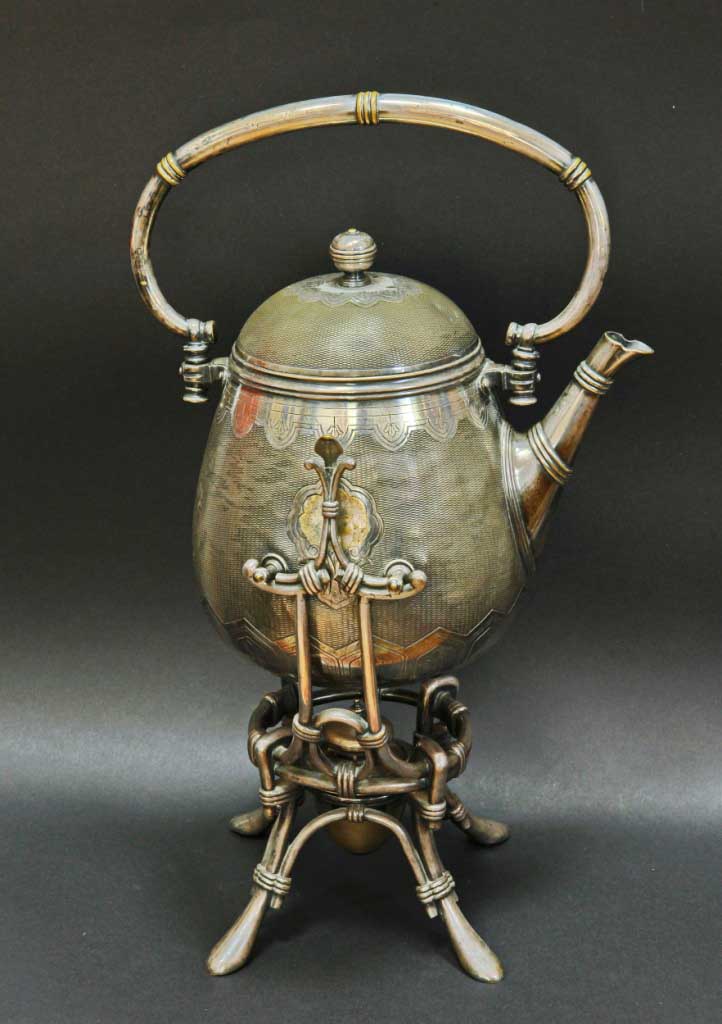  #Exhibit of the Month #Exhibit of the Month
June 2022
Teapot on a stand with a spirit lamp (bouillotte)
 The history of silverware goes back over 5,000 years, but only in the 3rd millennium BC, in Mesopotamia and Anatolia, the first pieces of processed silver were made. From there, the art of working with silver spread to Persia and to Europe, where already in Roman and Greek antiquity it reached a high level of skill. Many of the techniques used then, such as casting, embossing and engraving, are still used today. The history of silverware goes back over 5,000 years, but only in the 3rd millennium BC, in Mesopotamia and Anatolia, the first pieces of processed silver were made. From there, the art of working with silver spread to Persia and to Europe, where already in Roman and Greek antiquity it reached a high level of skill. Many of the techniques used then, such as casting, embossing and engraving, are still used today. The National Museum of History of Moldova possesses a rich collection of silver items, which in a special way reflects the everyday life of people of the 18th-20th centuries. The typological range of objects that make up the collection includes both secular and ecclesiastical silverware: fruit vases, bonbonnieres, cutlery, tea and coffee preparation and serving sets, salt-cellars, handbags, snuffboxes and cigarette cases, candelabra, as well as icon cases, chalices, pectoral crosses, candlesticks, and so on. Products of renowned jewelers, such as Fabergé, Khlebnikov, Sazikov in Russia, Elkington in England, Christofle in France or Norblin and Fraget in Poland stand out for their special quality and luxury. A significant item in the museum's silverware collection is the teapot on a stand with a spirit lamp (bouillotte), made in the Christofle workshop in France. The Christofle workshop was founded in Paris in 1830 by Charles Christofle. The workshop, which was the court supplier of the Emperor of France Napoleon III, the Emperor of Mexico and the Tsar of Russia, created decorative and household pieces of rare beauty. It was also highly appreciated by the Royal House of Romania, which granted the workshop a supplier patent. In 1842, Charles Christofle bought a patent for electroplating, a technique that involved first coating a metal base with copper and then with nickel and silver. It was this technique that allowed him to mass-produce silver tea sets, which were very popular at the time. Tea, brought to Europe in 1610 by the East India Company, was an expensive commodity that gradually gained popularity. The oldest preserved teapots, dating from the 1670s, were small. As tea gained popularity, larger teapots began to be produced, shaped to match the fashion of the time. According to Christofle catalogs, the model was produced in 1868 and fascinates with its elegance and refinement. The teapot has a complex design including a pear-shaped container, the surface of which is ornamented with guilloché in the Louis XVI style of the late 1780s. In the upper and lower parts of the body it is decorated with a border with tulips on protrusions, and in the center, it has an escutcheon with an engraved double frame. The teapot is equipped with a folding basket-like handle decorated with triple rings, and a lid with a knob. There are two rivets on the teapot for attaching it to the stand. A spirit lamp with a straight handle and a device for lifting the wick is fixed in the middle of the stand. The item has the Christofle stamp and is made of nickel silver. The teapot on a stand with a spirit lamp, made in the Christofle workshop, harmoniously combines the value of a unique object and a sample of a large industrial series. Dimensions: H.: 43 cm; W.: 24 cm.
|





 The side panels are elegantly decorated with refined cast-iron elements in the Art Nouveau style, displaying the brand name - "Ideal." The Polyglott model, featuring a bilingual keyboard patented in the United Kingdom by Max Klaczko from Riga, Latvia, was produced between 1902 and 1913, marking the first typewriter capable of writing in two languages. The "Ideal Polyglott" typewriter was actively sold in the Russian Empire and gained significant popularity in Poland, Bulgaria, and Serbia.
The side panels are elegantly decorated with refined cast-iron elements in the Art Nouveau style, displaying the brand name - "Ideal." The Polyglott model, featuring a bilingual keyboard patented in the United Kingdom by Max Klaczko from Riga, Latvia, was produced between 1902 and 1913, marking the first typewriter capable of writing in two languages. The "Ideal Polyglott" typewriter was actively sold in the Russian Empire and gained significant popularity in Poland, Bulgaria, and Serbia.













































